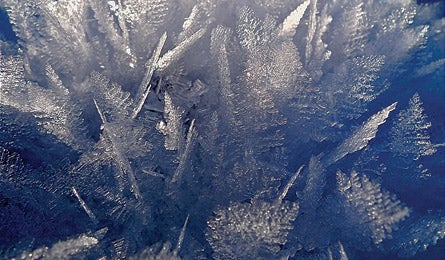Select a Safe Route: Study the Snowpack

'Surface Hoar'
Watch the Weather | Study the Snowpack
Travel Safe in Avy Terrain
SURFACE HOAR
These flat crystals (pictured, left) form at the surface when it’s humid and calm, but their structure is weak. Surface hoar creates common, hazardous layers in the backcountry.
CRUST
A glinting surface means ice, but a shiny crust presents little danger until it’s buried by new snow—where it becomes a slide surface for future avalanches.
POWDER
Large quantities of powder can set off some of the most destructive slides. It can stabilize within days if temps rise, but if it doesn’t settle, it often becomes a weak layer.
ROUNDED
Pellet-like crystals of old snow tend to form a strong, bonded layer, which creates a dangerous slab if it sits on top of weaker layers. If it’s deep in the snowpack, rounded snow forms a solid base.
FACETED
Temperature shifts in the snowpack cause diamond-shaped crystals, often called sugar snow, to form brittle, avy-prone layers.
WET
Taking many forms—from hard kernels to gloppy balls—wet snow coalesces into heavy slabs that, especially in spring, may slide unprovoked.
DEPTH HOAR
Large-grained crystals close to the ground form a hidden weak layer that may slide when disturbed from the base or side.